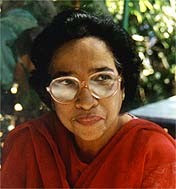 In summer, a trip to the Lake District is reviving. Wordsworth called it the place where ‘God and Nature commune.’ Its rolling hills and placid blue lakes under clouds tinted with empyrean light, give it an ‘other worldly’ ambience. Beatrix Potter author, illustrator and environmentalist lived here for most of her adult life. Though her books – Tales of Peter Rabbit, Tailor of Gloucester, Benjamin Bunny and other stories are now overshadowed by Harry Potter and his exciting antics, there was a time when children who read them were fascinated by her animal characters and even thought they lived with her, especially the much loved Peter Rabbit. People of the district thought of her as a neat and tidy ‘blue eyed bonny woman,’ just like her animal character Mrs. Twiggy Winkle.
In summer, a trip to the Lake District is reviving. Wordsworth called it the place where ‘God and Nature commune.’ Its rolling hills and placid blue lakes under clouds tinted with empyrean light, give it an ‘other worldly’ ambience. Beatrix Potter author, illustrator and environmentalist lived here for most of her adult life. Though her books – Tales of Peter Rabbit, Tailor of Gloucester, Benjamin Bunny and other stories are now overshadowed by Harry Potter and his exciting antics, there was a time when children who read them were fascinated by her animal characters and even thought they lived with her, especially the much loved Peter Rabbit. People of the district thought of her as a neat and tidy ‘blue eyed bonny woman,’ just like her animal character Mrs. Twiggy Winkle.Beatrix Potter was born on 28th July 1866, and spent the first 24 years of her life at 2, Bolton Place, London. She was tutored at home by governesses, in a claustrophobic school room on the top floor of her house. Her loneliness led her to create her own indoor animal farm by smuggling in her muffs and voluminous pockets, rabbits, mice and hedgehogs.
But for three months in summer every year, the family moved to Windermere in the Lake District, where she loved to roam over those green open spaces and breathe in the fresh air of the fells. Though Wray Castle where they stayed was a monstrosity, it overlooked the lakes and enjoyed the gentle refreshing breeze that blew inland.
The Reverend Drummond Rawnsley, Vicar of Windermere became her friend and guide, He showed keen interest in the animals which travelled with her in small cages or boxes, and encouraged her to make sketches of them or paint scenes from the countryside. He also stirred up in her a deep concern for preserving the natural beauty of the region. Her activities however were considerably hampered by an autocratic father and the responsibility of caring for her parents.
The royalties from her first book were used to purchase her beloved Hill Top Farm in Sawry. She could only make brief visits to the farm from London. But she used them well. John Cannon her tenant farmer taught her how to plant, hoe and use the farm implements. She also used this time to make sketches of houses, gardens, animals and the countryside, which she later incorporated into her books.
Beatrix’s obsession with preservation of the area in its natural splendour, prompted her to buy pieces of land and property when ever they came up for sale. This was to save them from demolition and commercial enterprise. Her only regret was that she could not spend enough time on her property, as her filial duties kept her in London for the better part of the year.
Beatrix was rescued from boredom and spinsterhood by William Heelis a solicitor, who belonged to the firm which managed her estates. Though her parents opposed her marriage, Bertram her brother argued that at 47, she had the right to marry whom she wanted.
Now she had more freedom to plunge into farming. She moved into larger quarters, and also worked tirelessly in the fields. Her one big obsession was to preserve the environment. She became an active member of Cannon Rawnsley’s National Trust. Acquiring property was not for any personal wealth but to prevent destruction of Nature by new constructions and tarred roads.
The villagers had no idea that she was an author, though her little books were on sale at the “Ginger and Pickles’ store in the village. To them she was an eccentric lady farmer, who wore rough clothes and stomped around in wooden clogs. Anyone who wanted to sell their property for shops, pubs and fancy houses, received a tongue lashing from her.
But she was generous to a fault with newly weds who couldn’t find accommodation or to widows who couldn’t support themselves. She even arranged for a district nurse to make herself available, and gave her a rent free cottage and a car. This was the beginning of the Hawkshead District Nursing Association. Her sympathy for those in need and her frugal life style endeared her to the people. When electricity came to the district in 1934, Beatrix preferred to stay with oil lamps and candles.
Beatrix died on December 22nd, 1943 at the age of 72. She bequeathed her extensive property to the National Trust of Lake District. Her shepherd of twenty years Tom Storey scattered her ashes on the Hill Top pastures, where her presence hovers benevolently over the quiet dales.
Beatrix’s books and personal effects are exhibited at Hill Top Farm. At the Beatrix Potter Gallery in Hawkshead, one can see her original drawings, story books and some of her endearing animal characters. Her whole life was devoted to green cause of the ‘most pleasant countryside in the world.’







